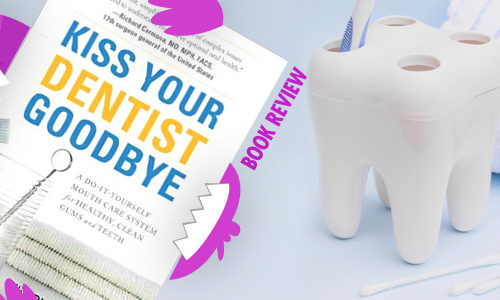
Book review: Cure Tooth Decay by Ramiel Nagel
Sneak peek: As we write these words, this book is absolute number one regarding healing and preventing tooth decay. The problem is, we are sceptical about many claims that the author makes, so instead a classic review with takaways this will be rather review and debunk format. Anyway, the objective of our work is to help you make right decisions and promote interventions that are scientific and actually work.
Two titles, one book, and many undeliverable promises
When you go to Amazon and look for books on dental health, especially on managing tooth decay this is hands down most popular book in the world (judging by the number of comments). It has been first published in 2010 and is now available under two titles: Cure Tooth Decay: Heal and Prevent Cavities with Nutrition and Cure Tooth Decay: Remineralize and Repair Cavities Naturally. Although ISBN numbers differ, content is identical. Change of the title is a marketing gimick – of course the word Heal sounds stronger and promises better than just Remineralize and Repair. We have to be honest, we don’t like the title, as it may be confusing for some readers. So let’s look what the word means:
heal – cause (a wound, injury, or person) to become sound or healthy again.
Is that even possible? No, it is not! Now, you may say that we are too picky and nobody is promising that kind of things. So there you have it, right in the introduction the author promises: You too can hope to achieve the following: (…) stop cavities – sometimes instantaneously (…) form new tooth enamel (…) heal and repair tooth infections.
So let’s put it as clear as possible:
- you can stop cavities, but this certainly won’t be instantaneous as it requires rebuilding your oral microbiome, and that’s a process that takes time
- growing (or forming) new enamel is not possible, this is an obvious lie
- tooth infections are serious conditions that may be life threatening, and although they can heal in most cases with infected pulp an attempt to do so is really unwise.
Then if these promises are not bad enough there are also testimonials, claiming that after following the author’s protocol: tooth pain subsided within 24 hours or root canals recommended by a doctor were no longer needed. If your infected tooth stops hurting it probably is not a sign of improvement, but rather a sign that the nerve died.
“Cure Tooth Decay: Heal and Prevent Cavities with Nutrition” by Ramiel Nagel is a book that has garnered attention for its unconventional approach to dental health. Please note that new editions or critiques of the book may have emerged since then, but this review will be based on information available up to 2021. The book claims to provide readers with insights into how changes in diet and nutrition can heal and prevent dental cavities.
Overview:
“Cure Tooth Decay: Heal and Prevent Cavities with Nutrition” is essentially an alternative health book that claims to offer insights into how nutrition plays a pivotal role in oral health. Ramiel Nagel, who is not a dentist or medical professional, draws extensively from the work of Weston A. Price, a dentist known for his theories on the role of nutrition in dental and physical health. The book espouses the notion that modern diets, especially those high in processed sugars and grains, are detrimental to dental health, and suggests that returning to a diet rich in certain nutrients can be more effective in preventing cavities than conventional dental care.
Positives:
Eye-Opening Perspectives: For readers who may not be familiar with the connection between diet and oral health, this book can serve as an eye-opener. It encourages readers to be mindful of what they consume and the possible implications on dental health.
Encourages Natural Solutions: The book highlights the importance of nutrient-dense foods such as vegetables, nuts, and dairy products, which generally are beneficial for overall health.
Comprehensive: Nagel presents an extensive array of information, including historical data, personal anecdotes, and nutritional suggestions.
Alternative Approaches: For those seeking alternatives to traditional dental treatments, this book provides different perspectives and options to explore.
Negatives:
Lack of Scientific Rigor: One of the most prominent criticisms of “Cure Tooth Decay” is that it lacks the scientific rigor expected of health-related publications. Nagel relies heavily on anecdotal evidence and the work of Weston A. Price, which, while pioneering for its time, is not without controversy.
Overemphasis on Nutrition: While nutrition is undeniably important for oral health, the book seems to downplay or even dismiss the importance of other factors such as genetics, oral hygiene practices, and the role of professional dental care.
Unrealistic Expectations: Some readers might be left with the impression that simply changing their diet could miraculously heal all their cavities, which is not a claim that is supported by mainstream dental science.
Potential Risks: Following the advice in this book without consulting a dental professional could potentially exacerbate dental problems or delay necessary treatments.
Author’s Credentials: Nagel is not a dentist or a healthcare professional, and his advice is not based on formal education in dentistry or nutrition. This raises concerns about the accuracy and reliability of the information presented.
Conclusion:
“Cure Tooth Decay: Heal and Prevent Cavities with Nutrition” by Ramiel Nagel is a thought-provoking book that challenges conventional dental wisdom by focusing on the role of nutrition in oral health. However, the book should be approached with caution due to the lack of scientific rigor, potential overreliance on anecdotal evidence, and the author’s lack of formal credentials in dentistry or nutrition. It’s important that readers do not substitute the information in this book for professional dental advice and care. Consulting with a dental professional and considering a range of perspectives is key to making informed decisions about oral health.
What’s good:
- coming soon
What’s bad:
- coming soon
The bottom line:
Coming soon
This book review is a work in progress and was published on June 12, 2018, and last updated on June 13, 2023.



